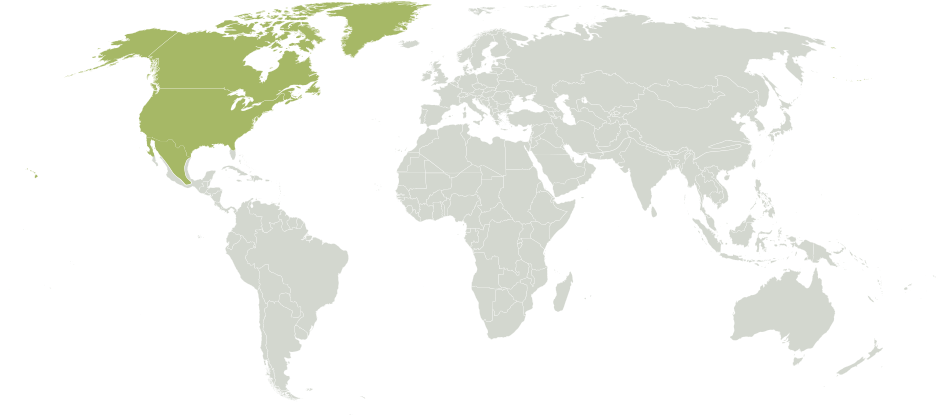Family: Megachilidae
Subfamily: Megachilinae
Tribe: Megachilini
Genus: Megachile Latreille, 1802
Subgenus: Cressoniella Mitchell, 1934
Common name: none
Megachile (Cressoniella) are medium-sized bees with black integumentintegument:
a tough, protective outer layer
and often with dense long hair that may or may not form pale apicalapical:
near or at the apex or end of any structure
bands hair on the tergaterga:
the segments on the top side of the abdomen, often abbreviated when referring to a specific segment to T1, T2, T3, T4, T5, T6, or T7 (Michener 2007Michener 2007:
(Michener 2007Michener 2007:
Michener, C.D. 2007. The Bees of the World (2nd ed.). Johns Hopkins University Press, Baltimore and London, 953 pp.). They range in body length from 9–15 mm (Michener 2007Michener 2007:
Michener, C.D. 2007. The Bees of the World (2nd ed.). Johns Hopkins University Press, Baltimore and London, 953 pp.; Gonzalez 2008Gonzalez 2008:
Gonzalez, V.H. 2008. Phylogeny and classification of the bee tribe Megachilini (Hymenoptera: Apoidea: Megachilidae), with emphasis on the genus Megachile. Thesis: Department of Ecology and Evolutionary Biology and the College of Liberal Arts and Science of the University of Kansas: 1-274.).
(modified from Mitchell 1935aMitchell 1935a:
Mitchell, T.B. 1935. A revision of the genus Megachile in the Nearctic region. Part II. Morphology of the male sternites and genital armature and the taxonomy of the subgenera Litomegachile, Neomegachile and Cressoniella (Hymenoptera: Megachilidae). Transactions of the American Entomological Society 61: 1-44.; Michener 2007Michener 2007:
Michener, C.D. 2007. The Bees of the World (2nd ed.). Johns Hopkins University Press, Baltimore and London, 953 pp.)
 .
. is straight in profile with distinct, erect hairs.
is straight in profile with distinct, erect hairs. preapicalpreapical:
preapicalpreapical:Megachile (Cressoniella) is a sister group to the subgenus Megachile (Dasymegachile), and they have species with similar sizes and hair patterns. Females are four-toothed in both subgenera, but the inner tooth of Megachile (Cressoniella) is truncatetruncate:
ending abruptly, or squared off
or notched, whereas it is acute in Megachile (Dasymegachile). Males of Megachile (Cressoniella) can be differentiated by their four-toothed mandibles and the lack of a spine on their front coxacoxa:
the basal segment of the leg.
Megachile (Cressoniella) is known to visit plants in the families Aizoaceae, Asteraceae, Asclepiadaceae, Fabaceae, Lamiaceae, Onagraceae, and Solanaceae (Butler 1965Butler 1965:
Butler, G.D. 1965. Distribution and host plants of leaf-cutter bees in Arizona. The Technical Bulletin of the Agricultural Experiment Station of University of Arizona 167: 1-19.; Raw 2007Raw 2007:
Raw, A. 2007. An annotated catalogue of the leafcutter and mason bees (genus Megachile ) of the Neotropics. Zootaxa 1601: 1-127.).
Megachile (Cressoniella) are leaf-cutter bees and use cut pieces of leaves to build their nest cells (Michener 2007Michener 2007:
Michener, C.D. 2007. The Bees of the World (2nd ed.). Johns Hopkins University Press, Baltimore and London, 953 pp.). One species, Megachile (Cressoniella) grandibarbis, has been found nesting in old beetle burrows in dead branches and in the soil using the leaves of the genus Nothofagus to build its nest cells (Raw 2007Raw 2007:
Raw, A. 2007. An annotated catalogue of the leafcutter and mason bees (genus Megachile ) of the Neotropics. Zootaxa 1601: 1-127.).
Megachile (Cressoniella) consists of twenty-one species (Raw 2007Raw 2007:
Raw, A. 2007. An annotated catalogue of the leafcutter and mason bees (genus Megachile ) of the Neotropics. Zootaxa 1601: 1-127.). Megachile (Cressoniella) zapoteca is the only species that occurs in the U.S. (Michener 2007Michener 2007:
Michener, C.D. 2007. The Bees of the World (2nd ed.). Johns Hopkins University Press, Baltimore and London, 953 pp.; Gonzalez 2008Gonzalez 2008:
Gonzalez, V.H. 2008. Phylogeny and classification of the bee tribe Megachilini (Hymenoptera: Apoidea: Megachilidae), with emphasis on the genus Megachile. Thesis: Department of Ecology and Evolutionary Biology and the College of Liberal Arts and Science of the University of Kansas: 1-274.).
There are no known invasives.
Megachile (Cressoniella) ranges from Arizona in the southern U.S. south to Argentina. They are predominantly found in xericxeric:
a very dry habitat
environments, but several species are found in high altitudes within the Andes (Michener 2007Michener 2007:
Michener, C.D. 2007. The Bees of the World (2nd ed.). Johns Hopkins University Press, Baltimore and London, 953 pp.; Raw 2007Raw 2007:
Raw, A. 2007. An annotated catalogue of the leafcutter and mason bees (genus Megachile ) of the Neotropics. Zootaxa 1601: 1-127.; Gonzalez 2008Gonzalez 2008:
Gonzalez, V.H. 2008. Phylogeny and classification of the bee tribe Megachilini (Hymenoptera: Apoidea: Megachilidae), with emphasis on the genus Megachile. Thesis: Department of Ecology and Evolutionary Biology and the College of Liberal Arts and Science of the University of Kansas: 1-274.).

Distribution map generated by Discover Life -- click on map for details, credits, and terms of use.
Butler, G.D. 1965. Distribution and host plants of leaf-cutter bees in Arizona. The Technical Bulletin of the Agricultural Experiment Station of University of Arizona 167: 1-19.
Gonzalez, V.H. 2008. Phylogeny and classification of the bee tribe Megachilini (Hymenoptera: Apoidea: Megachilidae), with emphasis on the genus Megachile. Thesis: Department of Ecology and Evolutionary Biology and the College of Liberal Arts and Science of the University of Kansas: 1-274.
Michener, C.D. 2007. The Bees of the World (2nd ed.). Johns Hopkins University Press, Baltimore and London, 953 pp.
Mitchell, T.B. 1935. A revision of the genus Megachile in the NearcticNearctic:
biogeographical region comprising North America as far south as northern Mexico, together with Greenland region. Part II. Morphology of the male sternites and genital armature and the taxonomy of the subgenera Litomegachile, Neomegachile and Cressoniella (Hymenoptera: Megachilidae). Transactions of the American Entomological Society 61: 1-44.
region. Part II. Morphology of the male sternites and genital armature and the taxonomy of the subgenera Litomegachile, Neomegachile and Cressoniella (Hymenoptera: Megachilidae). Transactions of the American Entomological Society 61: 1-44.
Raw, A. 2007. An annotated catalogue of the leafcutter and mason bees (genus Megachile) of the Neotropics. Zootaxa 1601: 1-127.